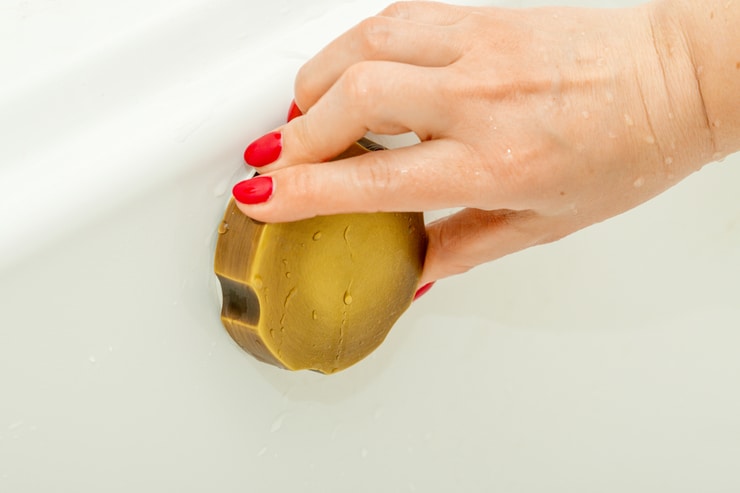Bathtub overflow drains, while helpful, are not actually a required part of your bathtub. You can get by just fine without an overflow drain, and there are a few reasons that you would not want one.
If you are one of those, who seek to seal off your overflow drain, there are many ways to accomplish this task.
This article delves into how overflow drains work, the purpose they serve, and why you would want to cover one up. We will also include a comprehensive list of solutions to help you seal off your bathtub’s overflow drain.

How Does A Bathtub Overflow Drain Work and Why Would You Want To Cover It
An overflow drain works in a very straightforward manner. When your bottom drain is plugged or sealed, your tub will fill with water. The overflow drain usually rests a few inches below the rim of your bathtub. When your bathwater reaches the height of the overflow drain, the water will exit through the overflow drain instead of spilling onto your floor.
The primary purpose of an overflow drain is to prevent water from spilling or overflowing onto your floor, so why would you not want one? The most common reason is that you desire a deeper soak in your bathtub. Overflow drains prevent a tub from being filled to the top, and without one, you can get a more full-body bathing experience.
Less common reasons include stylistic choices or a lack of small children making overflow drains somewhat unnecessary.
How to Cover the Overflow Drain in the Bathtub
Overflow Drain Cover
An overflow drain cover is a popular and effective way to seal up your overflow drain. These drain covers are usually made of plastic and use suction cups to cover over your overflow drain.
Many of these drain covers include a small hole at the top of your cover, allowing water to still drain while adding inches to your bathtub’s water level. In addition, these drain covers require no removal or modification to your existing overflow drain.
Overflow drain covers are very easy to install and are pretty inexpensive.
Attach a Chrome Plate
While drain covers have a small hole that still allows water to drain out, installing a chrome plate over your overflow drain will seal it off entirely. These plates are made of chrome because it does not oxidize or rust and can handle being soaked in water on a daily basis. They come in many different sizes to accommodate varying overflow drains.
Chrome plates require some work to install as you need to remove your existing overflow drain. Chrome plates can be installed using a few screws, and while costing a bit more than drain covers, they will definitely not break the bank.
Waterproof Sealant
You can remove your overflow drain and use a waterproof sealant to cover the opening, preventing water from passing through it. This method will likely put your bathtub out of commission for a day or two to give the sealant time to cure.
This is a more permanent solution as the sealant will be harder to remove than a plate or cover. You can reinstall your original drain cover over the sealant to avoid exposing it, giving you a more seamless look.
While waterproof sealant takes more time, it can be quite effective, inexpensive, and easy to install.
Waterproof Tape
Waterproof tape can be a viable yet temporary solution to seal off your bathtub overflow drain. You can use waterproof tape to cover the hole in your drain cover or the entire overflow opening.
You should expect the waterproof tape to give out eventually. But the worst-case scenario in using this tape is it will give out, and your overflow drain will start working again. But this tape is great to use while you wait for a more permanent solution.
Waterproof tape is relatively inexpensive and extremely easy to use but is not as durable or long-lasting as other solutions on this list.
Flex Seal
While Flex Seal is considered a waterproof sealant, it works much differently than traditional sealants by creating a waterproof rubber barrier. Additionally, Flex Seal is more versatile than your usual waterproof sealant.
For example, you can use it to seal a plastic drain cover, a pre-existing overflow drain, or even the opening behind the overflow drain. This flexibility is amazing, although I question how long Flex Seal will last under strenuous conditions.
Flex Seal costs a little more than most waterproof sealants but is easy to use and dries more quickly, although it may not be a permanent solution.
Plug Your Overflow Drain
If you are looking for a quick temporary solution, you can plug your overflow drain before each bath. This will require you to remove your drain cover. You can then use a rubber plug or even a washcloth to plug the hole that allows water to exit through your overflow. This method is obviously not a permanent solution but can work in a bind or if you do not want to cover your overflow drain permanently.
This method will cost you next to nothing and is very easy to do but lacks permanency because you will need to re-plug your overflow drain before each bath.
Buy A New Bathtub
While bathtubs without overflow drains are becoming rarer, they do exist and can be bought online and in some hardware stores. While replacing your bathtub is not a direct method to seal an overflow drain, it removes the overflow drain from the equation.
If you are due for a new bathtub and can afford it, this is a viable solution to get rid of an overflow drain. Besides the cost of the bathtub itself, there is also the cost of the installation to consider.
This is obviously the most expensive and labor-intensive method on this list, but it comes with the benefit of not having to worry about an overflow drain ever again.

